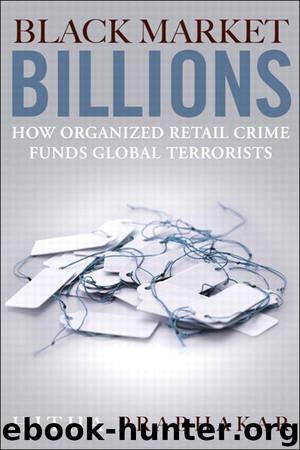Black Market Billions: How Organized Retail Crime Funds Global Terrorists (Gal Zentner's Library) by Prabhakar Hitha

Author:Prabhakar, Hitha [Prabhakar, Hitha]
Language: eng
Format: epub
Publisher: FT Press
Published: 2012-07-25T04:00:00+00:00
Organized Retail Crime and Latin America
In the past, terrorist financing usually came from the proceeds of drug sales, among other illicit transactions such as diamond sales, often utilized by Hezbollah. In the tri-border region between Paraguay, Argentina, and Brazil, terrorist organizations often sell cigarettes and pirated DVDs to finance their operations. The term “narcoterrorism” in the Latin American context describes drug trafficking organizations that use terror tactics, such as detonating a grenade in a packed public plaza, as a method to spread fear. The most notable was the drug war waged in Medellin, Colombia, which involved Pablo Escobar. He ran the Medellin drug cartel, making an estimated $30 billion annually.25 He waged war against the Colombian government through a series of hijackings, kidnappings, assassinations, and bombings. He wanted to change the extradition policies the government had put in place because of pressure from the U.S. government. The Medellin cartel eventually came tumbling down after Escobar’s much-celebrated assassination. However, organizations such as the FARC (Fuerzas Armadas Revolucionarias de Colombia) began attacking Colombian soldiers on a larger scale in 1982 as their income from the coca harvest increased. They also were able to fund the training of FARC fighters in Vietnam and Russia. The FARC’s primary source of income was drug trafficking until recently, when stringent international laws on drug traffickers began to be enforced.26 The result was a shift in fund-raising where FARC operatives work in conjunction with members of Mexican gangs, such as the Arellano-Felix organization and the Sinaloa Federation. The MS-13 has geographic roots in the Rampart Park area of Los Angeles, CA and cultural roots in Salvadoran culture due to the deportation of many of its members to El Salvador. MS-13 has an estimated 16 factions or “cliques” in the U.S. alone. Internationally the MS-13 has an estimated 36,000 members in seven countries. In the U.S. these cliques are located mostly in California, Maryland, and Texas, although MS-13 is present in all 50 states and in over 2,000 American cities, according to the FBI.
This is how it works: Profits from illegally sold merchandise are split into different funding sections. About 60% of the funds sent to the group’s country of origin goes to fund bribes to get members of the MS-13 out of prison in El Salvador, Colombia, Paraguay, or Mexico. In El Salvador, for example, judges make decisions based on written arguments, not oral. Therefore, there is very little accountability, and money talks, according to Samuel Logan, author of This Is for the Mara Salvatrucha and a Latin American security expert.27 Fifteen percent of the funds goes toward the operational costs of getting members of terrorist organizations, such as al Qaeda, into the country. This includes making fake passports and documents, for which al Qaeda members will pay double. They also need cash for hotel rooms, funds, and so on.28 Yet another 15% of the money is used to support families of MS-13 members who are imprisoned in the U.S. The remaining 10% is used to pay MS-13 mules, boosters, and fences.
Download
This site does not store any files on its server. We only index and link to content provided by other sites. Please contact the content providers to delete copyright contents if any and email us, we'll remove relevant links or contents immediately.
International Integration of the Brazilian Economy by Elias C. Grivoyannis(91181)
The Radium Girls by Kate Moore(11921)
Turbulence by E. J. Noyes(7936)
Nudge - Improving Decisions about Health, Wealth, and Happiness by Thaler Sunstein(7615)
The Black Swan by Nassim Nicholas Taleb(7010)
Rich Dad Poor Dad by Robert T. Kiyosaki(6403)
Pioneering Portfolio Management by David F. Swensen(6226)
Man-made Catastrophes and Risk Information Concealment by Dmitry Chernov & Didier Sornette(5921)
Zero to One by Peter Thiel(5686)
Secrecy World by Jake Bernstein(4646)
Millionaire: The Philanderer, Gambler, and Duelist Who Invented Modern Finance by Janet Gleeson(4376)
The Age of Surveillance Capitalism by Shoshana Zuboff(4210)
Skin in the Game by Nassim Nicholas Taleb(4162)
Bullshit Jobs by David Graeber(4095)
The Money Culture by Michael Lewis(4076)
Skin in the Game: Hidden Asymmetries in Daily Life by Nassim Nicholas Taleb(3929)
The Dhandho Investor by Mohnish Pabrai(3699)
The Wisdom of Finance by Mihir Desai(3654)
Blockchain Basics by Daniel Drescher(3507)
